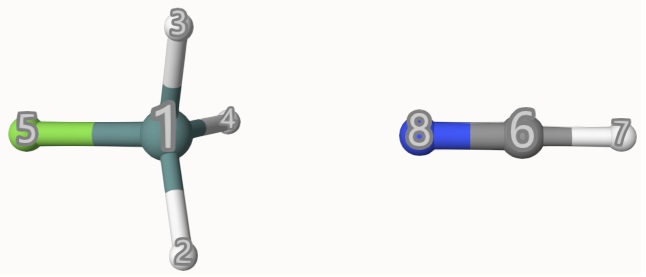Tip
All input files can be downloaded: Files.
basinfo
This keyword defines the implementation details of basis functions.
Options
- angular_type
Value
Cartesian. Will use Cartesian basis sets, i.e., 6d/10f/15g.spherical. Will use the spherical basis sets, i.e., 5d/7f/9g.Default
sphericalDetermine whether to use spherical or Cartesian GTO basis set. Usually, there is NO need to use Cartesian GTO basis sets except for test purpose.
- linear_dependence
Value
A real number
Default
1.E-8Assign the threshold that admits the linear dependence of the basis set. It should be a positive real number. When linear dependence is detected, Qbics will stop the calculation and raises an error.
Linear dependence occurs when:
There are identical basis functions for the same nuclear;
Two nuclei of the same element are too close;
There are many diffuse basis functions for a large molecule.
- ghost
Value
Atom range
Default
None
Assigning “ghost atoms” means that those atoms defined in
mol ... endhave basis functions, but nuclear and electrons disappear. This is often used for some special purposes, like basis set superposition error (BSSE) calculations, although Qbics can automatically do this.
Theoretical Background
Angular Type of Basis Functions
The analyitcal expression of Gaussian basis function is:
Here, \(A_{L}(\mathbf{r})\) is the angular part with angular momentum quantum number \(L\), \(K\) is the contraction degree, \(\alpha_k\) is the exponent, \(C_k\) is the contraction coefficient, and \(\mathbf{A}\) is the atom position.
The angular part \(A_{L}(\mathbf{r})\) has 2 forms: one is Cartesian, of the form \(x_A^{l_x}y_A^{l_y}z_A^{l_z}\), and spherical, of a real solid spherical harmonic function. The spherical basis sets are more efficient and compact for quantum chemical calculations.
Ghost Atoms
In quantum chemistry, ghost atoms are atoms that have basis functions but no nuclear and electrons. They are often used in basis set superposition error (BSSE) calculations, where the interaction between two molecules is calculated. The ghost atoms are used to remove the interaction between the basis functions of the two molecules.
One can use ghost option to calculate BSSE manually, but this is unnecessary. Qbics can automatically handle this by eda.
Input Examples
Example: GeH3F-NCH with Ghost Atoms
For the complex GeH3F-NCH, calculate the energy that HCN is the ghost molecule at B3LYP/def2-SVP level of theory:
1basis
2 def2-svp
3end
4
5basinfo
6 ghost 6-8 # The indices of HCN.
7end
8
9scf
10 charge 0
11 spin2p1 1
12 type R
13end
14
15mol
16 Ge 0.00000000 0.00221863 -0.79935317
17 H 0.00000000 1.48645043 -0.40384625
18 H 1.28514604 -0.74161126 -0.40477816
19 H -1.28514603 -0.74161126 -0.40477816
20 F 0.00000000 0.00108752 -2.56116087
21 C 0.00000000 -0.00225138 3.35662076
22 H 0.00000000 -0.00220444 4.43604901
23 N 0.00000000 -0.00207825 2.20326200
24end
25
26task
27 energy b3lyp
28end
The ghost keyword indicates that atom 6,7,8, i.e., C,H,N are ghost ones.

In the output, you can see:
1# of ghost atoms: 3
2 Indices: 6 7 8
3 Sum of ghost atom electrons: 14
4
5...
6
7SCF Structure:
8 # of electrons: 44
9 # of alpha electrons: 22
10 # of beta electrons: 22
11 2S+1: 1
The ghost atoms are listed. Also, the number of electrons are only 44, which is exactly the number of electrons for GeH3F only.